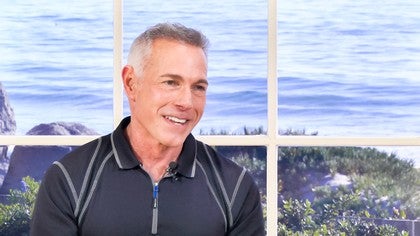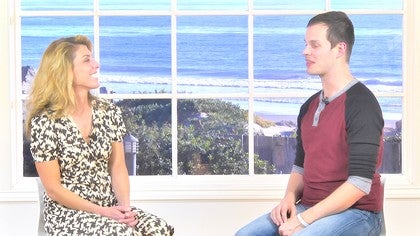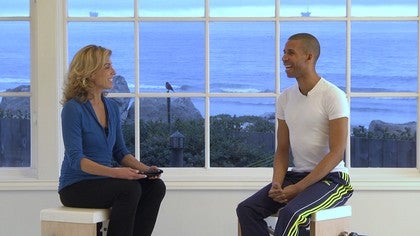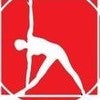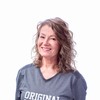Description
About This Video
Transcript
Read Full Transcript
My name is Kevin Bowen. I currently live in Denver, Colorado, and I have been teaching polities now this year. We'll make 19 years. My first exposure to plots was kind of a funny story because that's 16. Uh, I wasn't a really fit kid. I had lost a lot of weight, but I was never really athletic or involved in sports or activities or things of that nature. And I was in a Walden bookstore, which probably doesn't even exist anymore. And I'm one of the front tables. There was a book that said the [inaudible] method of mental and physical conditioning, which was obviously that first book that had been written besides Joe's, um, by, um, Gayle and Philip. And I looked at the book and I thumbed through it and I thought, wow, this looks really interesting. Maybe it's something that I should do. Being a, um, you know, 16 year old who didn't keep attention very long.
I just looked at it and moved on. So that was my first exposure to seeing the politesse method written out and having kind of a curiosity about it when I first looked at the book. You know, they're just, there's some moments in your life that's hard to describe where something kind of sits in your brain. Um, and it was a picture, you know, it was the picture of the book and that picture of that moment and for whatever reason it stayed in my head. So later when I actually learned about [inaudible], which was not until I moved to Santa Fe, which was many years later, um, I was introduced to [inaudible] with the first newsletter for the Institute for the plot is a method that Michelle Larson handed me. And I went, oh, and all of a sudden I had a little trick. I remembered that. I remember looking at that book at 16 and going, what the hell is this?
So it kind of all fell back into place again. And again. There was another time where I went, oh, okay, well that's interesting. But at that time I was teaching aerobics and crazy into that fitness scene and doing all of that stuff. And, um, I put it down on my desk and thought, well, I'll come back to this at some other point in my life, which I did, but, you know, at that point, I just wasn't, it wasn't the right time, let's put it that way. I really got into fitness because when I was went to college, I was working at Busch Gardens and I ended up going from working on a ride to getting into the entertainment department. And I used to do bird shows there. Um, yeah, I used to do birch shows at Busch gardens since, because I could, um, remember and talk and do a Q and do all of that other stuff.
And we had a spiel and we gave the spiel and we did all that stuff and we gave a show when we entertain people. And then they asked me to dance. And I had never danced before. So they taught me how to German dance gentlemen, German folklore, you know, folk dancing, I should say, where you're wearing the leader hosen and the whole thing in our female partners, we're all wearing journals. And, uh, one of the gals I danced with, she and her husband started an aerobics studio. So we used to, um, practice in the break room in between the six shows a day that we danced in. And I ended up going to her studio with her husband and started doing aerobic routines. And that was the first time I actually ran a short marathon was with them. So that was, I was 18 at the time back then.
I mean Joanne and Hanson started this aerobic studio and it was back when it was still jazzercise and she taught jazzercise. Joanne did and being a dancer and her husband was a dancer. She said I can do this better. And that's when they started their own studio and did their own routines. So what happened was I ended up moving to New York cause I left Busch Gardens and ended up going into retail management.
But I still basically was still practicing aerobics and doing things like that. I ended up moving to New York, got a job in retail there at Bloomingdale's and I actually ended up working for Estee Lauder working for the company directly. But in the store and started to do aerobics again. And that was back in the heyday in New York City when Jeff Martin and Molly Fox had these major studios. And so I started going there to basically exercise and I started teaching myself how to teach. But that was back in the day where 10 o'clock in the morning, you called up to get your spot at the five 30 class and by 10 oh five, the whole class, all, both classes of 40 people each were filled up.
So you had to go to the six 30 class. So that was kind of the timeframe that I learned that, you know, crazy fun, aerobics with a man being in the room and James Taylor and all of this stuff. It was a lot of fun. It was a lot of fun from New York. I ended up moving to Santa Fe. So that's how the Santa Fe connection came into my life.
And it was merely a fluke, could kind of fly with things in my life. And, um, I had been laid off from my job in New York and some friends were moving to Santa Fe. I moved out there with them. Uh, their family was very nice to me. They put me up for a little while. Um, I thought I was ready to teach aerobics and I went and sit under one's aerobics instructor even though I hadn't ever taught a class in my life. So I went in and I ended up doing pretty well and um, started teaching aerobics in Santa Fe and eventually opened an aerobics studio there. Um, got my certification in aerobics and group exercise of course, and did all those things. And a number of dancers used to use my studio to rehearsing cause there wasn't a lot of rehearsal space. Um, and one of those dancers was Michelle Larson and she was still dancing at the time. And that's where I had mentioned probably a little while ago. She brought me the first newsletter for the institute when she and Eve and Joan had started it. So that's my second introduction to [inaudible].
Michelle was renting space. I got introduced to it, I saw it. But again, I just never was interested enough to do something with it cause I was all wrapped up in that high impact high and the low impact high and the step high and all of that stuff. Uh, ended up closing my studio, went back into retail but continue to teach aerobics part time cause I just loved it. I got moved to San Francisco with the gap and went to San Francisco and then started teaching aerobics there as a part time Gig to make a little extra money because everyone knows retail didn't pay that much money. So I did that. Um, and basically through that time I continued to teach for a couple of years. So this is probably, I moved to San Francisco in 1992 ish, 93. Um, and there was a position open at the health club where I worked and because of my management background with the gap, they offered me the position as group exercise director for these two health clubs in San Francisco. And I took it. Um, and basically I started, you know, directing the programs and we were trying to be very competitive with the other clubs in town. And of course the, you know, the Premier Club at that point was the San Francisco Bay club. And I checked their schedules out and went to the club and did a little spine and realized they had yoga and pilates on the schedule and we didn't have either one.
So I put yoga on the schedule and I started doing some research about [inaudible], decided I wanted to add it to the schedule. So I hired someone who was already teaching at another club and I started to watch her class and her name was Stella Lavonne by the way. So she's been around for a while. She might still be in San Francisco, Stella, if you hear this, I love you. Um, and basically I still walked up to her and I said, this is really cool. I want to learn how to do this. Can you teach me? And she said, no, but I can send you to someone. And she sent me to Madeline black. So I walked into Madeline being a cocky personal trainer group exercise teacher who thought I knew it all.
Instead I wanted to learn how to teach pilates and I started her training program, which was through the Institute for the plotters method at that point. And that's what happened. And Madeline was very gracious but told me, you know, you really got to stop doing what you're doing if you're going to learn Palazzos. And I said to myself, I don't have to, I can continue teaching 14 classes a week and seeing my clients. And I went through a pile of these training program with her and um, was eating a lot of humble pie very quickly because I realized, um, how unknowingly incompetent I was, which means I don't know what I didn't know. I didn't know anything about that. In retrospect, when I look back at my first training, when I first started going for teacher training, um, it was hard because I hadn't been taught by someone specifically.
I was self taught and I was taught by other people. But no one really explored in depth, anything to do with within fitness about the body and how really it worked. All we knew where, whatever the, you know, quote unquote fad stuff was we could, what's going on? You know, we have to change aerobics now because we can't, you know, do any unsupported forward flection, which of course we do a lot of in plays, right? But the hard transition was Madeline would asked me to do something and here I thought, hell, I can do that. Just Shit. Excuse me. But I couldn't, I couldn't roll up. I couldn't do anything. And she kept after me. Let's get it straight. Let's get it straight. Come on, let's go. No, that's wrong. Let's try it again. So finally, you know, when everything started to integrate in, I kind of realized, okay, I've been doing this for six weeks and I feel better than I've ever felt in my whole life. What's going on? You know? Uh, and the big epiphany came of that feeling when I was actually walking our dog and when a Vista Park, which is above the Haight Ashbury there, and I was walking Tori in the park and I just thought, wow, I'm walking really differently like what's happening?
And I started to realize parts of my body that weren't even being touched by my regular fitness regimen. So of course, you know, I was sold and it made me feel much better. And I also started to realize how many injuries I actually had that I just kind of masked. Um, you know, I was teaching so many Arabic classes a week that I would wake up in the middle of the night to go to the bathroom for example, and I could barely walk to the bathroom because my feet were so sore and cramped up and it just cause pretty bad thing to have happen to you at 34, 35 years old. You know, you know, when I started training with Madeline and as I'd mentioned, I was frustrated because I thought I should be able to do everything I was asked to do. And then I was even more frustrated and perhaps even embarrassed that I couldn't. So then I just got pissed off. Right. So in the beginning, perhaps some of my pissed off miss went towards her because I kept thinking, well, she's making me look bad. It's not really me, it's her. And then I realized, oh, it's not really her, it's you, you're not doing it correctly. And that's where I started to keep going and going because I just realized, you know, I have a lot to learn here and you know, you have to, you have to, if you don't realize you have a lot to learn in life, no matter what age you are, you're just amazed as hang it all up.
So I just continued to go and, and did my best and was still frustrated. But that kept me moving. Back in the day when we first started that training program, we did dif the different phases of the way the physical mind or the Institute for the [inaudible] method was set up. So basically we were allowed to start teaching after three months, but only basic, you know, simple mat classes and things. And the recommendation had been for us only to start teaching math.
So I didn't really teach in San Francisco when I was still there. I only did the training for three months there, four months. Um, but I ended up then moving again to Miami with my partner at the time. So once I got to Miami, I started teaching pilates Mat classes, which I was cleared to do. And I also continued teaching step because needed to make a living. Um, and as that started to happen, you know, then I, you know, realized everything you realize as a new PyLadies teacher that you over-correct and you over, blah, blah, blah, and you're not really being a great teacher and people were not coming to my classes and I couldn't understand what was wrong. Like, why isn't anyone coming to this pilates class? It's the best thing, you know, of course. Then I finally said to myself, a couple of people pulled me aside who were teachers in town said, well, maybe you should just rethink how you're teaching. Um, so I did, uh, and also simultaneously around the same time I got recruited by David Barton because of my background in fitness and my management background, they recruited me to become the general manager for his gym that he opened up in Miami beach. And I went to David Barton. David Barton, um, was, it still is, he's a fitness quote unquote persona out of New York. Uh, he, uh, started a gym, uh, in Chelsea and woe years ago in the early nineties, but because of his wife and partner or his partner at the time who became his wife, Suzanne Barsh, they had the, um, what we laughingly referred to as the velvet mafia group.
And the velvet mafia is the quote unquote, you know, artistic fashion east, a side of the group of New Yorkers who went to the gyms. So it was typical, you know, Mary McFadden was a client and all of these major people, his partner at the time was the publisher of w magazine. So these were the people that David had around him. Um, and the Delano hotel, when I opened that gym, that was Ian Schrager who was from studio 54. So, you know, we opened, um, the first Thanksgiving at the Delano, you know, I was in, I was thrown into a scene I'd never been in before. I had Madonna and I had Katie Lang and I had Cindy Crawford and I had Eric Roberts and I had Julia Roberts and I had Barry Diller and all of these people were in and out of the gym because it was the gym at the Delano. And the Delano was the hottest hotel. And so that's who David Barton was.
So everything was the scene. It was a scene we'll be in the scene with. Everything was, was a cool thing. You know, it, you don't realize what it was until after it happens, I think. But I also knew that I really loved [inaudible] and I was not, you know, really fulfilling my desires to learn more. So that's what happened when I went to New York, as I knew that back in my head when I first went to [inaudible], one of the things I said to myself, which I still say to this day, is no matter what happens, I can always teach polities even when I retire. And I always still think that way.
Even no matter what little projects I go off on or anything that I do, I can always go back to teaching PyLadies. And not that it's a fallback, but it's, I knew it's something that I cared about that much that I could do that. So I ended up at Debra's door because when I called the institute, they had already gone through a big shuffle. And Debra had been one of the instructors there. You know, one of the group that ran the institutes program, but she wasn't involved anymore. But the person who was working there gave me her name, which they really weren't supposed to do. So I went to Deborah's and we met each other and looked at each other and we ended up talking about [inaudible] and then the lawsuit that was going on at the time.
And the reason why that came up is because I had been served papers to cease and desist teaching PyLadies in Miami beach or I was going to get sued. And I brought that up to Debra. She brought it up to me, we bonded. And then I ended up going through a training program, or at least finishing the training program. I had started with her. So when I, when I first went to Deborah's, I didn't know what to expect and I walked in and, um, you know, she had quite a cool, funky loft space in New York City. And as we continued our conversation, um, I mentioned something about the lawsuit and when I mentioned something, I also said, you know, I just don't understand how someone can tell me. I can't say that I teach Palladio's when this is what I've been trained to do.
And that's when Deborah said, well, you know, I'm involved in that suit and I'm actually one of the people who's helping with the lawsuit. So we ended up having a conversation about that. And consequently as I started work or teaching there I should say, well not really teaching learning. And then we started apprenticing and everything. I ended up assisting Debra with, you know, some of the help that she needed with the lawsuit, which was a fundraiser. Um, and a few other items. And one of the attorneys who was involved on the case was a client at the studio. So I ended up becoming intimately involved with, you know, what was going on. And during that time I kept saying, what are we gonna do if this doesn't work out?
And we can't say the word [inaudible]. And none of us can say that. I mean, because we literally answering the phone, Green Street studio, we would never say plots and people would call up then and they would ask you leading questions, what do you do there? Exactly what goes on in that studio, what do you teach? And usually it would be the other side's attorney's trying to catch you in something. So we would always say we teach the exercise methods based upon Joseph h [inaudible] teaching a little crazy. But you know, that's, that's how I was because I hadn't been practicing so much on the equipment, more so on the mat. I was pretty decent at teaching mat. I got better at it, but the equipment was where I had a falling apart. Like, Oh boy, you know, I wasn't practicing on it enough and we all know what it's like. You have to really practice and know it. Um, and Deborah was very kind about things. And um, one time in particular, uh, when we were apprenticing in the studio, um, and I would always be there in the afternoons. Um, she had a specific routine that was set up and she knew that I didn't know it.
I mean a menu of the exercises and I may know how to change the springs, but I didn't know what came next. And all the clients had a very set routine except for a few that were injured. Um, and they usually, Debra took care of them on one of the senior teachers. So she gave me a 14 year old to work with who was the daughter of two clients who came to the studio. And um, you know, I said, okay, I got up and I didn't know anything. I didn't know what exercises came next.
There was the longest hour of my entire life. The Jessica, I think that's what her name was. She kept telling me what was the next sweet thing and it was from, I never forget it was from five to six, it must have been a Tuesday night. And I finished it six and Deborah looked at me and said, you're going to go home and learn the routine, aren't you? And I said, [inaudible] and I was squirming, squirming. If you could see me, I must've been like squirming completely because this 14 year old knew the routine better than I did. And here I was supposed to be teaching her and I just, you know, you know, and I think it's a pretty common experience when you go through a mentoring training that you get stuck in a situation like that. When you know, you think you know it all or you think you have a pretty good grasp on it and you know your teacher can go, mm, I don't think so. Let's just see.
And you know, you need to go through that. Uh, the, the interesting thing about working at Debra's being in, in that kind of a heavy mentoring situation was the fact that we took corrections we had, so if she was in the other part of the loft and you were doing something wrong, she had equalized and she would say, Kevin, the feet don't go there on foot work no matter who was in the studio, no matter what was going on. And you know, I've done teacher training of course, because it's been years since that happened and so many people get so upset if you correct them. But no, the bottom line was suck it up man. Get a hard show. And learn how to do it because you've got to learn and you weren't getting corrected because she didn't care. You were getting corrected because she wanted you to do it the right way. Um, and that, that was invaluable for me because you had to step back and become a little bit more humble. And you know, the last thing that I like, and I'm sure most people is getting embarrassed in front of other people because you don't know something. And that's what happened on the consistent basis until you did learn it. When I went first, went to [inaudible] not knowing anything and realizing the first realization that occurred that I didn't really know what I was doing was probably the best thing that happened with Madeline. But then as I proceeded in, move through it, and I started to go through, you know, training and being with Debra, um, I didn't like the fact that I couldn't do something.
Um, and that probably comes to that side of my personality, that Capricorn side, where I want to be successful at what I'm doing. So as I started to get through this, I just said, no, I'm going to learn how to do this. And I wanted to get to a point where I felt comfortable enough that then I could assist myself with being a teacher. So in other words, what that means to me is in the beginning I wrote everything down. Everything was written down. I wrote everything down. We didn't have pictures in those first books. You know, we didn't, you know, stick figures on all the exercises. What did they look like? What happened?
You know, Deborah said this, I'm gonna write that down. I ringed out, used to be a client in the studio. So she would come in and say things, you know, and here we were as apprentices with Irene Dowd and she'd be doing something and I'd look at Deborah and Deborah would look at me and say, I'm not going to correct her or you. And I thought, I'm not correcting I Irene out because she intimidates the hell out of me. Back then she did. Right? Because I realized what knowledge she had. But I also just wanted to get to the point where I felt comfortable that I could go out on my own and start to learn it as well, so that someone got me to a specific point and there are others obviously in life it will bring me to other levels. But I wasn't about to stop. And that motivation at that time because I loved Palati so much because it was so positive for me. It was very um, empowering and the other motivation truly came from the lawsuit back to something I said before, which was the thought that I really love this and I would like to share it with other people and someone's gonna say, you can't because I owned the name. Um, that really motivated the hell out of me because I just thought that's not right. Um, and that's, that's a whole other case scenario and it's neither here nor there and the situation, that's what motivated me.
I got to the point where this is really important. It's important. Something needs to be done with the work. Something needs to be happening with the work. And I just didn't feel like I could rest until I did something myself. Cause they gave myself a personal challenge. And then I thought, well, I don't want to be calling myself a loser.
It's one thing if somebody calls you a loser, but once you call yourself a loser, that's not a good thing. If you understand what I'm saying there. And I just kept going, you know, I've gotta, I've gotta continue this. And, um, it's just opened up a world of different things for me, you know, different possibilities, different thought processes, different understanding of the body. Um, and more importantly, people, you know, I think life in general, you know, it was an, it was an inside segway or side door into understanding other things that fascinated me, which really had to do with people, emotions, personalities, how the world works, what goes on. Um, and that was [inaudible] for me, that was all I even really knew about it was that it was more than just exercise. There was something deeper to it, if that makes any sense at all. But that's, that's what it was for me.
The Teacher's Corner: Discussions
Comments
You need to be a subscriber to post a comment.
Please Log In or Create an Account to start your free trial.
